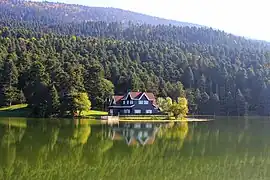Bolu Province
Bolu ili | |
|---|---|
 Lake Gölcük | |
 Location of the province within Turkey | |
| Country | Turkey |
| Seat | Bolu |
| Government | |
| • Vali | Erkan Kılıç |
| Area | 8,313 km2 (3,210 sq mi) |
| Population (2022)[1] | 320,824 |
| • Density | 39/km2 (100/sq mi) |
| Time zone | TRT (UTC+3) |
| Area code | 0374 |
| Website | www |

Bolu Province (Turkish: Bolu ili) is a province situated in north-western Turkey. It is located between the capital, Ankara, and the largest city in the country, Istanbul. Its area is 8,313 km2,[2] and its population is 320,824 (2022).[1] The capital city of the province is Bolu.
Geography
The province is drained by the Bolu River (Boli Su) and the Koca River.
The forests, lakes, and mountains are rich in wildlife including three deer species, and popular weekend and holiday retreats for walkers and climbers.
Parts of the province are vulnerable to earthquakes.
History
It is not known when Bolu was first founded. Some archaeological findings date back about 100,000 years that suggest the region was inhabited then.
The area now in Bolu Province was in eastern Bithynia and southwestern Paphlagonia. The town of Bithynium from which the area takes its name is the modern Bolu. The area was called Bithynia during the Hellenistic period, the Romans named it Claudiopolis, and it was called Bolu by the Turks.[3] By about 375 BCE, Bithynia had gained its independence from Persia under Artaxerxes II, and King Bas subsequently defeated Alexander's attempt to take it.[4] The Bithynian region with parts of Paphlagonia remained its kingdom until 88 BCE when it briefly came under Mithridates VI and the Kingdom of Pontus. With Roman help the last Bithynian king, Nicomedes IV regained his throne, but on his death bequeathed the kingdom to Rome. This led to the Third Mithridatic War and the fall of Pontus, the area was incorporated into the Roman Empire as a single province joining Paphlagonia with Bithynia. Under the falling Byzantine Empire the Bolu area was divided from western Bithynia at the Sakarya River, with western Bithynia keeping the name. The Sakarya is still the southern and western boundary of the province.
The Byzantine Empire briefly lost the Bolu area to the Seljuk Turks after the 1071 Battle of Manzikert, but recovered it under Alexios I Komnenos. After the end of the Komnenos dynasty, the Turks gradually took the Bolu area back.
About 1240 the Seljuk Turks took the eastern part of the Bolu area (i.e. the Paphlagonian part) from the Byzantine Empire and incorporated it into the Sultanate of Rum. Due to their assistance in taking it and Sinop, the Chobanids were given that territory and adjacent areas to the north and east to rule. The Chobanids were relatively independent of the Sultan. That eastern area fell under the Isfendiyarids between 1292 and 1461. In 1461 it was incorporated into the rest of the Ottoman Empire by Mehmed II.
By 1265, the western part of the Bolu area was again acquired by the Seljuk Turks, but it fell to the arms of Orhan and the Ottoman Empire in the early to mid-1300s. The two areas were reunited in 1461, under Mehmed II. In the 1864 Ottoman Empire administrative reorganization, Bolu was created as an independent sanjak,[5] although it was geographically part of the Kastamonu Vilayet.
Administrative divisions
Bolu province is divided into nine districts, four sub-districts, thirteen municipalities, and 491 villages.
Districts

Main sights
- Lake Abant, a mountain lake resort and hot springs
- Yedigöller National Park. The name means "seven lakes" in Turkish, referring to the number of lakes in this forest park.
- The Köroğlu Mountains, said to be the scene of the folk Epic of Köroğlu
- There are many hot springs and mineral baths in the province (kaplıcaları in Turkish).
- Kartalkaya, one of Turkey's most popular ski resorts
- Sarıalan, a lake high in the mountains above Kartalkaya
- The Aladağ mountains, including the trail and picnic area of Gölcük
- Seben Çeltikler
- Göynük Akshemseddin Mausoleum
Towns include:
Gallery
 Bolu Gölcük Nature Park Aerial View
Bolu Gölcük Nature Park Aerial View Mist early in the morning
Mist early in the morning A scene from Yedigöller
A scene from Yedigöller Bolu Gölcük Nature Park side view of the State Guesthouse
Bolu Gölcük Nature Park side view of the State Guesthouse Snowy wooden house
Snowy wooden house
See also
References
- 1 2 "Address-based population registration system (ADNKS) results dated 31 December 2022, Favorite Reports" (XLS). TÜİK. Retrieved 19 September 2023.
- ↑ "İl ve İlçe Yüz ölçümleri". General Directorate of Mapping. Retrieved 19 September 2023.
- ↑ All About Turkey - Bolu
- ↑ Memnon, History of Heracleia, 12
- ↑ Naval staff, Intelligence Department (Royal Navy) (1919). A handbook of Asia Minor. Vol. 1. London. p. 226.
{{cite book}}: CS1 maint: location missing publisher (link)
External links
- (in Turkish) Official website
- (in Turkish) Bolu municipality's official website
